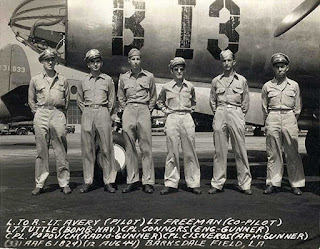 |
| James Avery, 95th birthday party, December 2016 |
I first met Mr. Avery at our family's print shop, when I was a boy. He was a focused printing customer, who knew exactly what he wanted, and several generations of my family worked hard to make sure we met his expectations. He was always kind to me, and to everyone at our print shop, and I have fond memories of him.
 |
| The crew of Avery's B-26, which flew 44 bombing missions over Europe in World War II |
During World War II, in March, 1943, Avery was sent to Lackland. Later, he went to Fort Stockton for primary pilot training, San Angelo for basic training, and on to Lubbock, where he earned his wings in January, 1944.
After Lubbock, Avery was sent to Laughlin Field in Del Rio, where he learned to fly the Martin Marauder, the B-26. The B-26 had a bad reputation, since there were a lot of accidents, especially on take-offs and landings.
Avery met his crew in Shreveport, Louisiana, and they were assigned a new B-26, which they flew from Florida to England, by way of the Caribbean, South America, Ascension Island, Liberia, Dakar, Morocco, and then Wales. The trip took nine days.
Together they flew 44 bombing missions in Europe from bases in France.
After the war, Avery returned to the University of Illinois to complete his degree.
After graduation, Avery was offered a position at the University of Iowa to set up a new Industrial Design program in the Fine Arts department. He was only 24 years old.
Two years later, he moved on to the University of Colorado, where he taught in the Fine Arts school for five years.
During this time personal issues caused Avery to become very involved with his church, and with campus youth ministries at the University of Colorado. While in Colorado, he met a young woman from Kerrville, Sally Ranger, who became his second wife in 1953.
Together they moved to Minneapolis, where Avery taught at the University of Minnesota. A very cold winter there helped them decide to move back to Texas.
The couple arrived in Kerrville in June, 1954. In his in-laws' garage, James Avery built a workshop, putting up Celotex on the interior walls, building a workbench, and setting up a polishing lathe. It was there, with a few hand tools, pieces of sterling silver and copper, James Avery started making jewelry.
He'd had some experience making jewelry during his days at the University of Colorado, where some of his students asked if they could design and make jewelry. Avery went to the library, found a book, and he and his students learned how to make jewelry together.
"Designing was not a problem" Avery said, years ago. "Fabricating was."
For the first three years of jewelry making in Kerrville, Avery made every piece himself by hand. He even had a catalog printed, by General Moran, who'd set up a print shop at his house on Jackson Road. Francis "Fuzzy" Swayze took the photos for that first catalog. Prices for the pieces ranged from around $2.50 to $10.00.
"Since I had to make by hand every piece shown in the catalog," Avery said, "I fortunately didn't get swamped with orders."
 |
| Avery designs on some very attractive notepaper. |
In 1957, Avery hired his first employee, Fred Garcia. "I wouldn't be here today if it were not for Fred and the wonderful people who have helped me these past almost 55 years," Avery remarked in 2007.
The first store outside of Kerrville opened in Dallas in 1973. Today there are around 80 stores across the United States, and over 3,500 employees.
Not too many years ago I stopped by Mr. Avery's office in Kerrville. It turned out to be the last time I saw him there. He was in his nineties at the time.
I stepped into his office and did not see him, but I heard a quiet tapping in a small adjoining room. There I found him at his workbench, a small hammer in hand, working on a piece of silver jewelry in a vise. Hand tools and a small saw were on the worktable. Before him there was a piece of paper with a pencil-drawn design. A bright light shone on the piece, and was reflected on Avery's face. He was smiling.
That's how I'll remember him: At work, alone, at his workbench, quietly making jewelry.
Until next week, all the best.
Joe Herring Jr. is a Kerrville native who tries each week to tell the story of our community This column originally appeared in the Kerrville Daily Times May 5, 2018.


No comments:
Post a Comment
Please remember this is a rated "family" blog. Anything worse than a "PG" rated comment will not be posted. Grandmas and their grandkids read this, so please, be considerate.